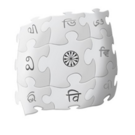Santali Language
Santali Language
Santali (IPA: [santaɽi]) is an Austroasiatic language belonging to the Munda subfamily. It is primarily spoken in eastern India, Bangladesh, Bhutan, and Nepal, with approximately 7.6 million speakers worldwide. This makes it the third most widely spoken Austroasiatic language, after Vietnamese and Khmer. The language is officially recognized in India's Constitution under the Eighth Schedule.
Writing System[edit | edit source]
Historically an oral language, Santali acquired written forms through several developments:
- The Ol Chiki script, created by Raghunath Murmu in 1925, serves as the primary writing system
- Alternative scripts include Bengali, Odia, and Roman alphabets
- Ol Chiki is distinct from other Indic scripts, using an alphabetic rather than syllabic system
- In Bangladesh, the Bengali script remains the predominant writing system
Historical Development[edit | edit source]
The Munda language family, to which Santali belongs, is believed to have originated in Indochina. According to linguistic research by Paul Sidwell, these languages likely reached the Odisha coast approximately 3500-4000 years ago, following the Indo-Aryan migration to the region.
The documentation of Santali began in the 19th century through European scholarly efforts:
- Early documentation by anthropologists and missionaries
- Notable contributors included A. R. Campbell, Lars Skrefsrud, and Paul Bodding
- Their work produced the first dictionaries and formal studies of Santali grammar
Geographic Distribution[edit | edit source]
Regional Distribution in India[edit | edit source]
The majority of Santali speakers reside in India, with the 2011 census recording 7,368,192 speakers (including Karmali and Mahli variants). The distribution by state is as follows:
1. Jharkhand: 44.4% (2.75 million)
2. West Bengal: 33% (2.43 million)
3. Odisha: 11.7% (0.86 million)
4. Bihar: 6.2% (0.46 million)
5. Assam: 2.9% (0.21 million)
6. Other states: 1.8%
Areas of Concentration[edit | edit source]
Major concentrations of Santali speakers are found in:
- Santhal Pargana division (Jharkhand)
- East Singhbhum and Seraikela Kharsawan districts (Jharkhand)
- Jangalmahals region (West Bengal)
- Mayurbhanj district (Odisha)
Official Status and Recognition[edit | edit source]
Santali holds several official designations:
- One of India's 22 scheduled languages
- Additional official language in Jharkhand and West Bengal
- Recognized for academic use by the University Grants Commission (2013)
Linguistic Features[edit | edit source]
Phonology[edit | edit source]
== Consonant System ==[edit | edit source]
Santali features 21 basic consonants, with additional aspirated stops primarily found in Indo-Aryan loanwords. Key characteristics include:
- Complete series of voiced and voiceless stops
- Word-final stops are glottalized and unreleased
- Neutralization of voicing contrasts in word-final position
== Vowel System ==[edit | edit source]
The language has:
- 8 oral vowels
- 6 nasal vowel phonemes
- Nasalization contrasts for all vowels except /e/ and /o/
- Multiple diphthongs
Dialects[edit | edit source]
Major dialectal variations include:
- Kamari-Santali
- Khole
- Lohari-Santali
- Mahali
- Manjhi
- Paharia
Each dialect maintains the core features of Santali while exhibiting distinct regional characteristics.
